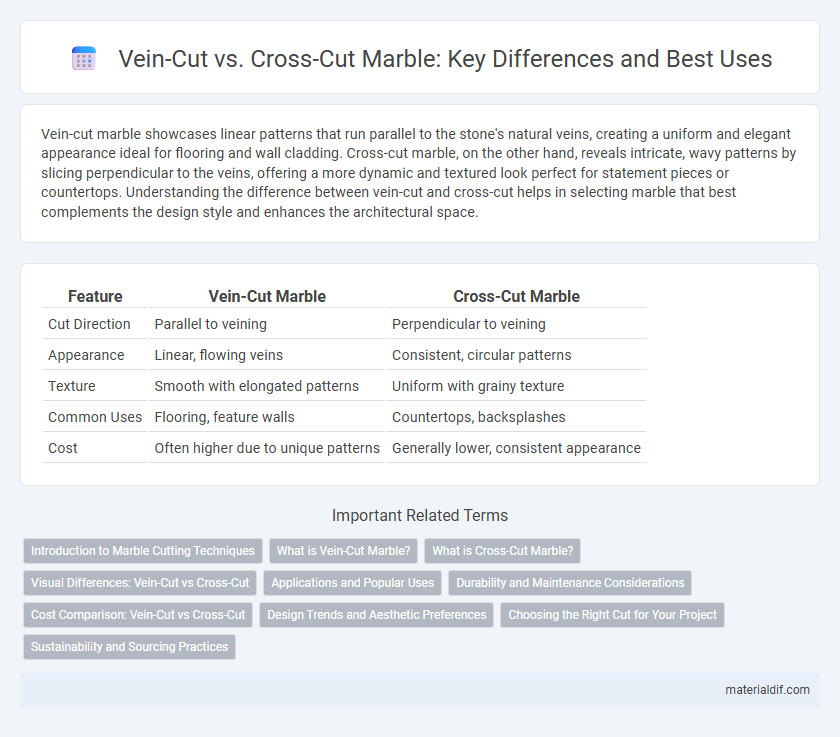Vein-cut marble showcases linear patterns that run parallel to the stone's natural veins, creating a uniform and elegant appearance ideal for flooring and wall cladding. Cross-cut marble, on the other hand, reveals intricate, wavy patterns by slicing perpendicular to the veins, offering a more dynamic and textured look perfect for statement pieces or countertops. Understanding the difference between vein-cut and cross-cut helps in selecting marble that best complements the design style and enhances the architectural space.
Table of Comparison
| Feature | Vein-Cut Marble | Cross-Cut Marble |
|---|---|---|
| Cut Direction | Parallel to veining | Perpendicular to veining |
| Appearance | Linear, flowing veins | Consistent, circular patterns |
| Texture | Smooth with elongated patterns | Uniform with grainy texture |
| Common Uses | Flooring, feature walls | Countertops, backsplashes |
| Cost | Often higher due to unique patterns | Generally lower, consistent appearance |
Introduction to Marble Cutting Techniques
Vein-cut marble slicing runs parallel to the stone's natural veins, showcasing elongated, linear patterns that enhance the marble's intrinsic flow and elegance. Cross-cut marble cutting slices perpendicular to the veins, creating more uniform, blocky patterns that emphasize texture over linearity. Choosing between vein-cut and cross-cut techniques influences the aesthetic appeal and application suitability in architectural and design projects.
What is Vein-Cut Marble?
Vein-cut marble is a type of marble slab cut parallel to the natural veins, highlighting continuous linear patterns that create a flowing, elegant appearance. This cutting technique reveals long, dramatic striations that emphasize the stone's natural veining, often preferred for sophisticated architectural applications and luxurious interiors. Vein-cut marble enhances spaces by showcasing the distinctive beauty and texture of the stone's unique mineral formations.
What is Cross-Cut Marble?
Cross-cut marble refers to slabs that are cut perpendicular to the stone's natural veins, creating a unique pattern where the veins appear as short, irregular lines or speckles. This cutting technique highlights intricate details and produces a more uniform, mosaic-like surface compared to vein-cut marble. Cross-cut marble is often preferred for modern designs that emphasize texture and subtlety rather than linear vein patterns.
Visual Differences: Vein-Cut vs Cross-Cut
Vein-cut marble showcases linear, flowing patterns following the stone's natural veins, creating a striking and elegant visual effect. Cross-cut marble reveals concentric or circular patterns with more uniformity and symmetry, highlighting the stone's natural texture from a perpendicular angle. These distinct visual differences in vein orientation significantly influence marble's aesthetic appeal and design applications.
Applications and Popular Uses
Vein-cut marble showcases linear, flowing patterns ideal for elegant flooring, wall cladding, and countertops in residential and commercial spaces seeking a sophisticated, natural look. Cross-cut marble reveals blockier, more geometric patterns suited for decorative accents, tabletops, and accent walls, offering a contemporary and bold aesthetic. Both cuts are popular in luxury interiors, with vein-cut favored for seamless, elongated designs and cross-cut chosen for striking, mosaic-like visual effects.
Durability and Maintenance Considerations
Vein-cut marble showcases linear veins that enhance its natural pattern, offering consistent durability suitable for high-traffic areas, while cross-cut marble reveals more varied and intricate textures that may require extra maintenance to preserve its appearance. Durability of vein-cut marble generally withstands wear and tear better due to its aligned grain, whereas cross-cut marble's exposed surfaces can be more prone to chipping and staining without proper sealing. Maintenance for vein-cut marble involves routine cleaning and periodic sealing, whereas cross-cut marble demands more meticulous care to maintain its aesthetic integrity and prevent damage over time.
Cost Comparison: Vein-Cut vs Cross-Cut
Vein-cut marble typically incurs higher costs due to its labor-intensive extraction process, which requires more precision to align the stone's natural veins. Cross-cut marble tends to be more economical as it is sliced perpendicular to the veins, maximizing material yield and reducing waste. Cost variations also depend on the marble type, quarry location, and finishing techniques applied to each cut.
Design Trends and Aesthetic Preferences
Vein-cut marble, characterized by parallel lines running along the slab, emphasizes linear patterns that align with modern design trends favoring sleek, continuous flows for minimalist and contemporary spaces. Cross-cut marble features a more fragmented, intricate veining pattern showcasing natural complexity, appealing to aesthetic preferences that highlight texture and depth in classical and eclectic interiors. Designers increasingly select vein-cut marble for elegant uniformity in large installations, while cross-cut options are chosen for statement pieces where unique, dynamic visuals are desired.
Choosing the Right Cut for Your Project
Vein-cut marble showcases the natural veining running parallel to the stone's surface, creating a linear and dramatic pattern ideal for highlighting continuous designs in flooring or countertops. Cross-cut marble slices perpendicular to the veining, producing a more uniform and subtle texture that suits intricate tile work and smaller applications. Selecting the right cut depends on your project's aesthetic goals, scale, and the desired visual impact of marble patterns.
Sustainability and Sourcing Practices
Vein-cut marble, sourced by slicing parallel to the stone's natural veins, tends to preserve more of the quarry's structure, reducing waste and supporting sustainable extraction practices. Cross-cut marble, cut perpendicular to veins, often generates higher waste due to its irregular patterns and increased offcuts, impacting resource efficiency negatively. Prioritizing vein-cut marble aligns with eco-friendly sourcing by maximizing material yield and minimizing quarry disturbance.
Vein-cut vs Cross-cut Infographic

 materialdif.com
materialdif.com